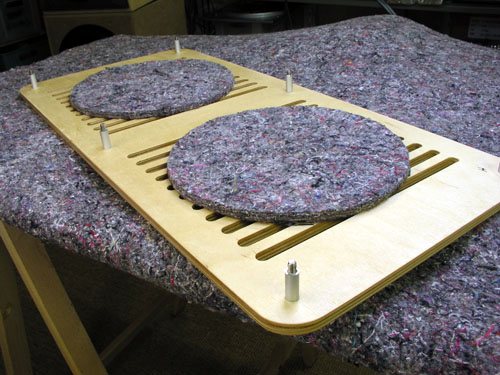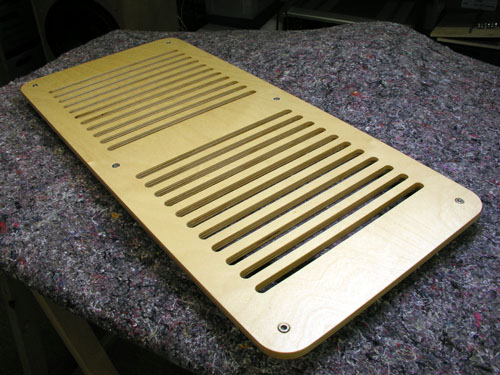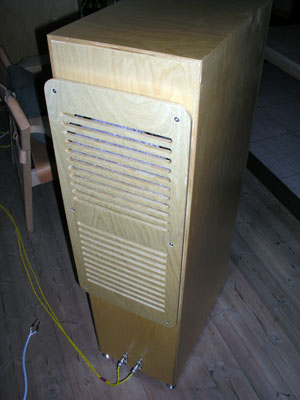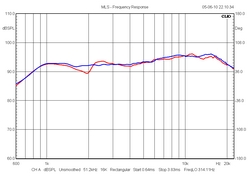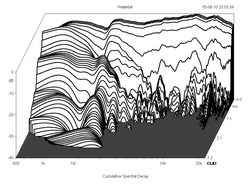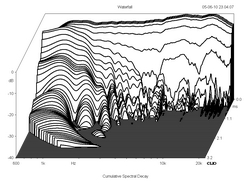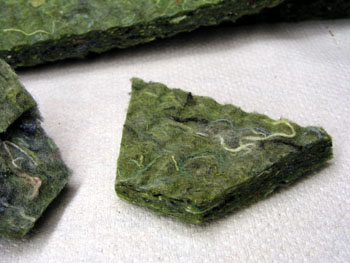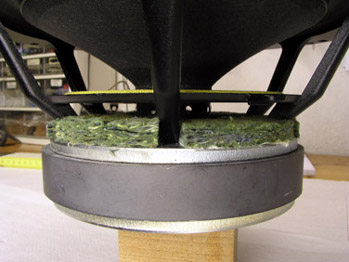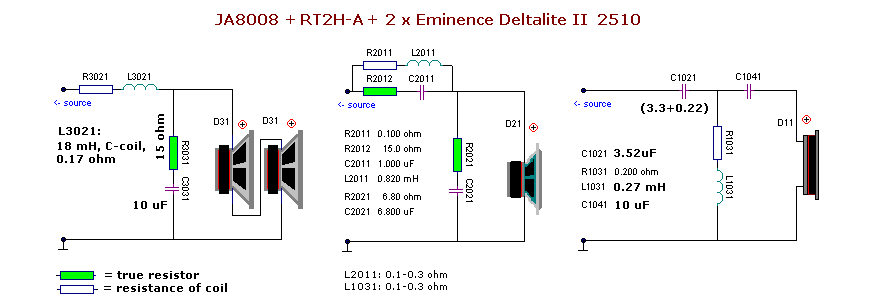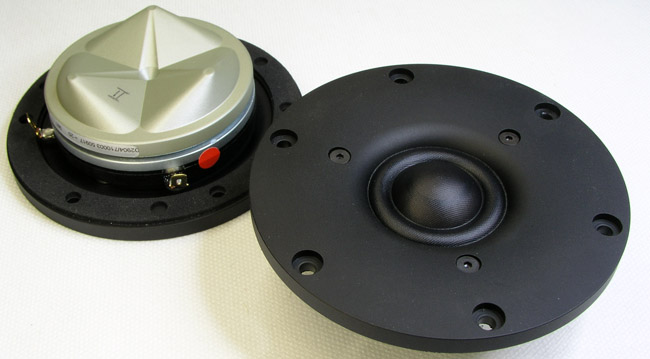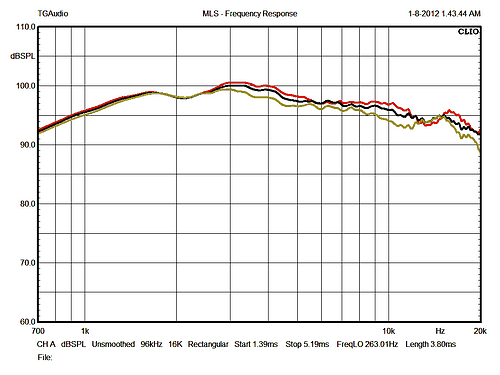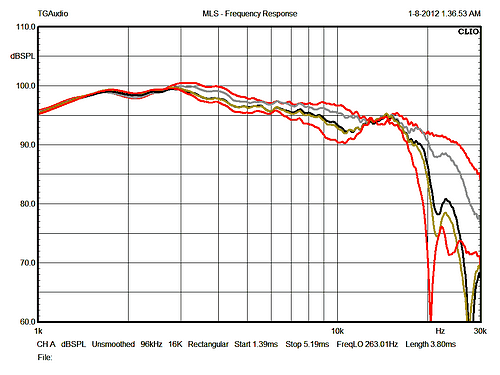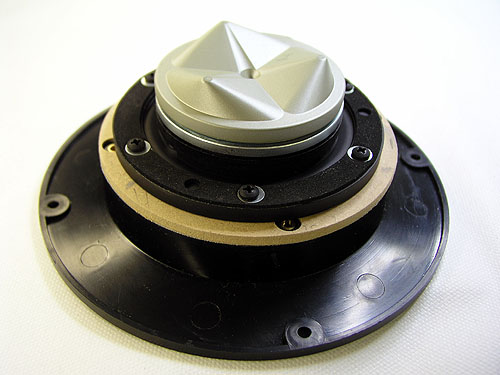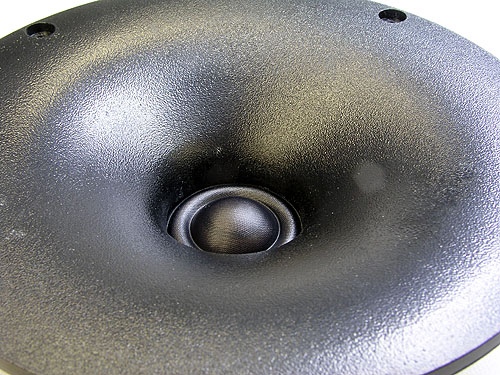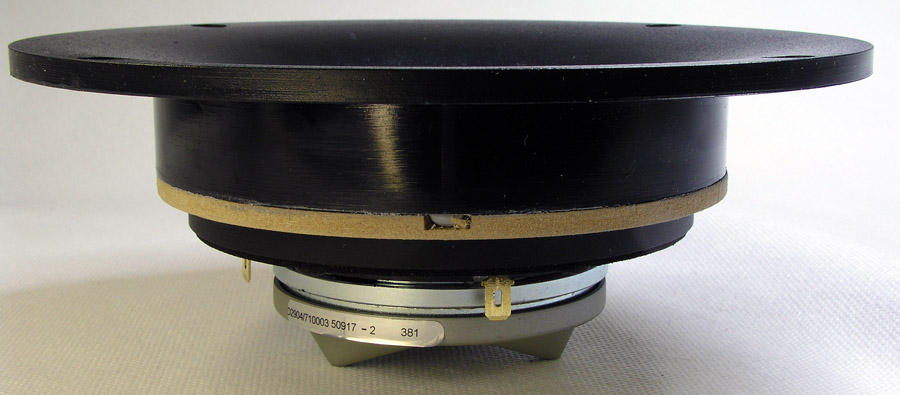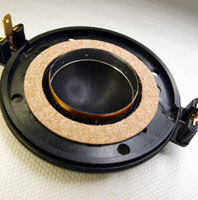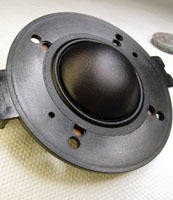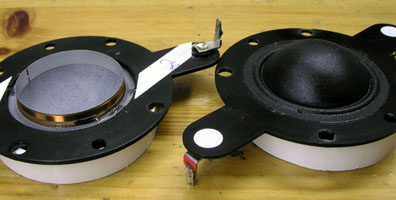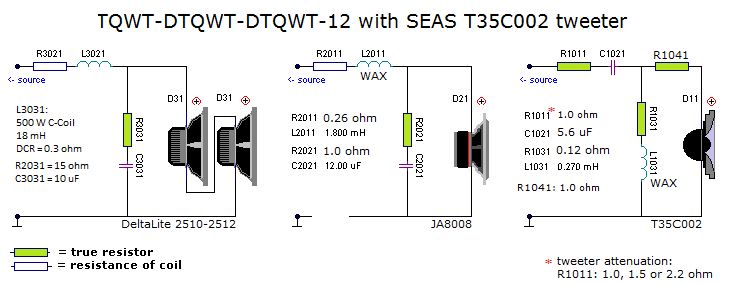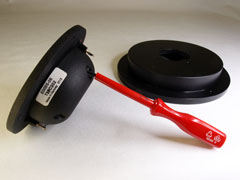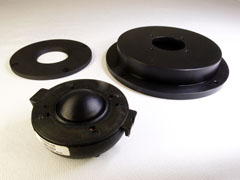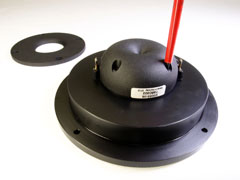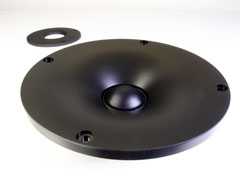DIY Loudspeakers: HOME INDEX UPDATES RESPONSE WHAT'S NEW
DTQWT TWEAKS
mkII
crossover
Damping
rear radiation
Audax
mods
Damping
of magnet
|
|
It's been more than 3 years
since the work on the DTQWT began. Already
in 2006 when the driver parameters were decided in
collaboration with SEAS/Norway, the speaker following the
TQWT was in
preparation and it's been a great satisfaction seeing it
in the hands of many diy'ers. That the JA8008 driver also
has gained interest outside the diy community was no less
pleasing. As pointed out in the TQWT file, there are
numerous applications for the JA8008 driver and it's
great fun having reports back on what people have
created.
I need to address some sincere thanks to my friend Michael, who got me in touch with Jantzen Audio taking the financial risk of the whole project of launching an extended range 8" driver. Had it not been for Michael and our discussions on how we could have a new "Vifa C17" produced somehow, the JA8008 driver would never have been made. Yes, it all started with the Vifa C17 driver, but taking this driver into production would require significant investments, where most parts for the JA8008 driver were already at hand at SEAS. Generally I find an 8" driver more versatile, where a 6" driver soon calls for a companion (d'Appolito or 2½-way). The
DTQWT construction has been been my main speaker
for the last two years and I don't think this will change
for a foreseeable future. There are numerous projects I'd
like to do with the JA8008 as the main driver, but time
is a limiting factor and making big cabinets takes time.
Even the QUATTRO construction
took longer than anticipated despite an uncomplicated 40
liter vented cabinet. |
WHAT IF? |
|
The search for better sound
is a never ending story and many experiments have been
carried out over the last two years to possibly improve
the performance of the DTQWT, but nothing came up that
would produce a DTQWT-mkII until recently. Below comments
on some of the tweaks tried, some reported briefly, some
in more detail.
Tweaking the crossover was
where the most significant change for the better
appeared. Read about the mkII crossover below, tweak #1.
The simpler the crossover, the more options
available for final voicing of the speaker it appears.
With an LR2 crossover even minor changes to values of the
cap, the coil (including its series resistor) can make
radical changes to the voicing of the speaker. SWANS RT2H-A planar tweeters unit were in my test cabs for 3 months last summer - and it took a good friend to tell me "this isn't really as good as the old one, or...?" And he was right, it wasn't. Treble as such was great, but overall integration just didn't work out. I render this more important than any specific tweeter quality we may fancy. I don't like listening to tweeters, I like listening to treble, good treble that blends well with the midbass driver. Fountek JP2 tweeter was tried for a long time but driver integration was even worse than the SWANS planar. Ribbons usually require steep crossovers unless crossed very high and this wasn't a good match for the JA8008, at least not with my set-up and with my crossover. Others may have found differently. Damping upper pole piece of the JA8008 was tried and didn't improve performance. Reported below. The discussion on reflections from the magnet system onto the thin cones of dynamic drivers is still going strong and some have even taken out patents to protect their non-reflection designs (Vandersteen) and I had hopes there was some gain here, but to the best of my auditive ability this simply didn't make any difference. Recent years have seen a lot of designs trying to minimise reflections from the magnet - and I'm not sure this is as important as it is claimed to be. It takes more to make a good sounding driver than the size of the magnet behind the cone. Smoothing impedance peaks in the 20-100 Hz region by LCR circuits was pretty much a disaster. I wanted to hear what would happen from getting a flatter impedance but as the 8008 and the bass drivers need their own individually tuned circuits, this proved extremely difficult and when I finally got it right ( - or did I?) it just killed the intentional collaboration between the front driver and rear bass drivers loading the same center horn. Not a good idea. Modifying TW034 dome by venting the center pole piece and cavity below voice coil has been tried and yes, it makes a slightly better tweeter suitable for very low points of crossover. For the DTQWT this tweak didn't pay off, having a point of crossover at ~3 kHz. Partly reported below with link to page describing the full modification. Damping rear radiation from the bass driver has been tried and yes, some experiments are useful here. Read below. |
Tweak #1 |
The QUATTRO speaker was
where new ideas to a simplified crossover emerged based
on work done on the PRELUDE crossover in
combination with the article on Siri'S
Killer note. The QUATTRO having a different
working point to the crossover, due to the baffle step
compensation circuit, allowed a very simple LR2 crossover
to the tweeter and quickly this topology was tested in
modelling and practice for the TQWT/DTQWT speakers as
well. The revised crossover was tested for another long
period of time and found to improve the sound enough to
justify an "mkII" addition to the TQWT/DTQWT
names although the changes on paper seem very modest. The impact on sound can be described very simple: Enhanced transparency. I could also put it this way: Easier to listen to, more natural timbre, a slightly "darker" sound although I'm hesitant to write this as people may think treble level has gone down, where in fact it is slightly increased in amplitude, but within experimental error. You will more easily be able to identify the location of events in the musical landscape, e.g. I have found it easier to hear Keith Jarrett's "aahhh-aahhh..." or "beep-beep-beep...." singing, which may not be to everyone's taste, but nevertheless more fidelity! I'm sure I'll have the question if it is worth while and my answer is yes, but some may have gotten used to the "mkI" sound and prefer this. For those with a box of coil/cap leftovers, it may be beneficial to try it out before investing in the best of components. Whether your ears will hear the same as mine I certainly cannot tell. The crossover changes have been implemented in the TQWT and DTQWT constructions and file headings are TQWT mkII and DTQWT mkII. Obviously the changes can be implemented in OB9 too, but I haven't yet heard from anyone building these large panels. Check up-dated files on TQWT mkII and DTQWT mkII
Should you want to upgrade your existing DTQWT crossover, you need one of the following options: Option 1: Option 2: 2 x 16 AWG 0.18 mH wax coils, 2 x 5.6 uF Superior Z-caps, 2 x 1.0 ohm 5-10 watt MOX resistors. Option 3: 2 x 16 AWG 0.18 mH wax coils, 2 x 5.6 uF Silver Z-caps, 2 x 1.0 ohm 5-10 watt MOX resistors. Option 4: 2 x 16 AWG 0.18 mH wax coils, 2 x 2.2 + 3.3 uF Silver Gold Z-caps, 2 x 1.0 ohm 5-10 watt MOX resistors. Download Kit Sale, Option 1 here. I'm deliberately calling these suggestions "options" and not "levels", although there may be sonic differences. Going from standard low-cost polyprops (STANDARD Z-Cap) to the super caps - to my ears - deliver significant enhanced level of detail and transparency. There may be sonic differences between Superior Z-Caps and Silver Z-caps, but in the end it may be a matter of taste. I haven't tried the Silver/Gold option, but some people just want the best regardless of price. The future default DTQWT
kit will include option 3 as the omission of the two 8.2
uF Superior Z-caps more than pays for now the single
Silver Z-cap. The majority of kits sold are with Superior
Z-caps and WAX coils according to Jantzen Audio. Download image here to upgrade your existing crossover.
|
Tweak #2 |
The two Eminence bass drivers facing your front wall are driven from a simple 1st order filter and do radiate some energy in upper bass/lower mid into the room. Being in phase with the front driver we have a bi-pole situation in contrast to a di-pole speaker, where rear energy is out of phase with front radiation. A bi-pole speaker approaches a 360 deg. soundfield, where a di-pole have a "null" (dead) zone that may require extra precautions with regard to speaker placement and sitting position. However, for the DTQWT only working in lower registers, this is of less importance as bass notes are omnidirectional anyway. I have to point out
immediately that we cannot wire the DTQWT bass driver
with inverted polarity as these and the front driver load
the same center horn and the result would be no bass - or
very little.
My mockup panels really don't deserve photos. I'll add pics once the final panels are finished. The panels are 280 x 600 mm and made from 12 mm Baltic birch with 10 mm slots as shown on drawing. This actually does take some time with the router I can tell. Find your own solution if this seems too laborous. Initially it was my plan to make a rear grille with standard grille cloth, but I thought the Baltic birch solution nicer. The panel is attached with 6 screws with 15 mm spacers made from aluminium tube. Two Ø 22 cm circular sheets of 10 mm felt material is placed concentric to the bass drivers. That's all. The slots and the quality of the felt are open for experimentation. With no slots, I'd leave 20 mm to the rear panel. Experiment with felt material and thickness as this is not overly critical. For initial experiments, just hang a towel from the top with a 10-20 mm spacer and hear what happens.
|
First of all: With the chosen point of crossover and the 2nd order filter topology for the DTQWT tweeter, there is no advantage in modifying the TW034 dome. The modification is only justified when we think of using the TW034 dome down to around 1.5 kHz and examples will be shown at a later moment. TW034 tweeters come with foam damping domes on the solid center pole piece and as a result we have a minor wrinkle in response at 2 kHz.
A full report on TW034 modification can be found here. |
|
Tweak #5 |
SWANS RT2H-A planar tweeter was tried out extensively last summer and just didn't integrate well with the JA8008 driver. I badly wanted this to work out right but had to give it up. Too many visitors had thumbs down and they were right. The crossover below was one of the solutions tried, but no matter what I tried the upper mid and treble didn't gel properly.
|
Tweak #6 |
|
Tweak #7 |
|
I have a
box of Monacor waveguides cut to various depths for a quick test on
tweeters to pick those suitable for applying a waveguide. Not all
tweeters perform well with a waveguide and I've found it pretty much
unpredictable. It has to be tried. The
"DTQWT-71" has been evaluated extensively against my reference
DTQWT and there are minor differences although hard to pin-point.
Due to the deeper waveguide - I guess - I find the best sound from less
toeing in compared to the Audax, which can cope with on-axis listening
without problems. I really can't tell which is the better performer, but
for sure the 7100 gets my full recommendation. Basically I like having
alternatives to provide choices for the builders, although I'm
constantly asked which is the better. In that sense it's better having a
single product, which is put together from specific drivers, period!
Go to website on how to implement the Monacor waveguide here. How to make an adaptor for your existing waveguide to accommodate the 7100 tweeter here.
|
|
Tweak
#8 May 2013
SEAS T35C002 tweeter with waveguide BACK TO TOP |
|
When the SEAS T35C002 dome was released in Europe I ordered a
pair to see if they would fit the TW034 waveguide because due to the
rear chamber it might do the same thing as the modified Audax TW034 dome can
do: Go lower and allowing the point of crossover between 8008 and dome
tweeter to be taken down to around 2 kHz providing a bit more presence and
better dispersion in upper mid and lower treble. |


